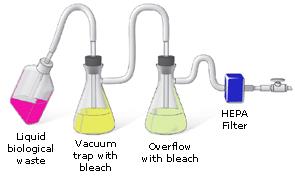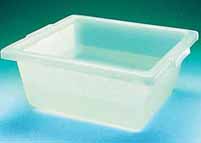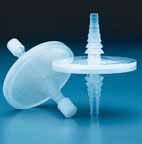Vacuum systems (both centralized and stand-alone pumps) are commonly used to help researchers filter reagents and dispose of waste. It is very important to protect your vacuum system from the biohazardous pathogens and biotoxins routinely used in research. Vacuum systems protect labs, building staff, and the environment from liquid contamination and dangerous aerosols. The OSHA bloodborne pathogen standard states: "Vacuum lines shall be protected with liquid disinfectant traps and high efficiency particulate air (HEPA) filters or filters of equivalent or superior efficiency which are checked routinely and maintained or replaced as necessary."
The images below are examples of safety equipment and accessories that meet university policy requirements for vacuum line protection. These items can be purchased from many distributors (e.g., Fisher Scientific, VWR) Catalog numbers are listed as a reference.
Vacuum Line Protection
The first sidearm flask functions as the vacuum trap and the second acts as the overflow back-up. These two flasks contain enough household bleach so that the final concentration of waste is 10% bleach when full. An in-line HEPA filter is the last defense and prevents aerosols from entering the line. The flasks should be set in a plastic bucket or tray so that if they break, the spill is easily contained. This image is adapted from the Biosafety in Microbiological and Biomedical Laboratories (BMBL) 5th Edition, Appendix A.


Secondary Containment Trays

Sides should be high enough to contain liquids in case a flask breaks (Nalgene Polypropylene Sterilizing Trays Fishersci cat# 13-359)
In-line HEPA Filters

HEPA filters remove 99.97% of .3mm particles and protect house vacuum lines from contamination (Millipore Millex Filter Units Fishersci cat# SLFG85010 and SLFG025LS)